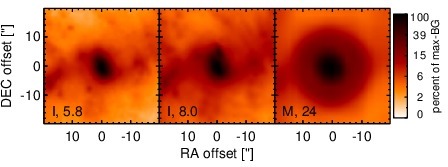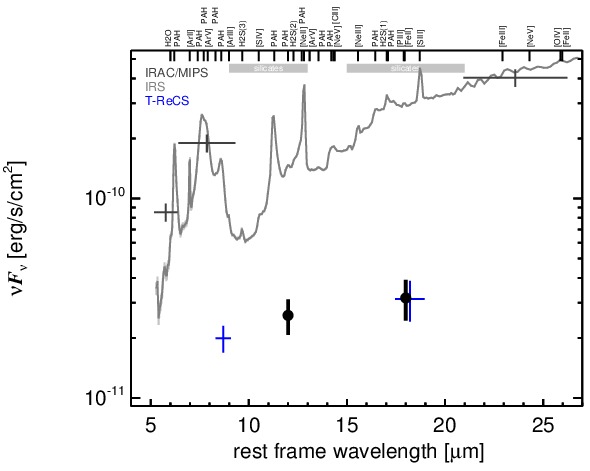Sasmirala Individual Information for NGC 6221
Description
NGC 6221 is a barred late-type spiral galaxy at a low Galactic latitude at a distance of D = 10.7 ± 4.3 Mpc (NED redshift-independent median) with an active nucleus containing a clumpy starburst and a Sy 2 nucleus (see [levenson_obscuring_2001] for a detailed study). This results in a AGN/starburst composite classification (e.g. [veron_agns_1997]). In particular, the AGN is surrounded by several compact star clusters. A compact radio core with linear extended emission of ~ 6arcsec ~ 300 pc along PA~ 40∘ was detected at radio wavelengths [morganti_radio_1999]. We conservatively treat NGC 6221 as an uncertain AGN. The first ground-based MIR observations were performed by [glass_mid-infrared_1982], followed by [roche_atlas_1991]. In addition, NGC 6221 was observed with ISO [bendo_infrared_2002] and Spitzer/IRAC, IRS and MIPS. The corresponding IRAC and MIPS images show an elongated, bright nuclear emission region (diameter~ 7arcsec ~360 pc; PA~ 30∘) embedded within the spiral-like host emission. The IRS LR staring-mode spectrum exhibits strong PAH emission, a possible silicate 10 μm absorption feature, and a steep red spectral slope in νFν-space (see also [pereira-santaella_mid-infrared_2010]). Thus, the arcsecond-scale MIR SED seems to be completely star-formation dominated. The nuclear region of NGC 6221 was observed with T-ReCS in the Si2 and Qa filters in 2009 [ramos_almeida_testing_2011]. In both images, an extended nucleus (FWHM(major axis)~ 0.6arcsec ~ 30 pc; PA~ 32∘) embedded within aligned arc-like extended emission and a second compact source ~ 1.75arcsec ~ 90 pc to the south-west (PA~ 305∘) are detected. The latter source is associated with a compact star-forming region [ramos_almeida_testing_2011]. We use manually-scaled PSF photometry to measure the nuclear flux. This methods provide values that are consistent with [ramos_almeida_testing_2011] and on average ~ 87% lower than the Spitzer spectrophotometry. The resulting nuclear MIR SED might, however, still be affected by star-formation emission.
- [bendo_infrared_2002] George J. Bendo, Robert D. Joseph, Martyn Wells, Pascal Gallais, Martin Haas, Ana M. Heras, Ulrich Klaas, René J. Laureijs, Kieron Leech, Dietrich Lemke, Leo Metcalfe, Michael Rowan-Robinson, Bernhard Schulz, and Charles Telesco. An infrared space observatory atlas of bright spiral galaxies . AJ , 123 pp. 3067–3107, June 2002.
- [glass_mid-infrared_1982] I. S. Glass, A. F. M. Moorwood, and W. Eichendorf. Mid-infrared observations of seyfert 1 and narrow-line x-ray galaxies . A&A , 107 pp. 276–282, March 1982.
- [levenson_obscuring_2001] N. A. Levenson, R. Cid Fernandes, K. A. Weaver, T. M. Heckman, and T. Storchi-Bergmann. The obscuring starburst of NGC 6221 and implications for the hard x-ray background . ApJ , 557 pp. 54–66, August 2001.
- [morganti_radio_1999] R. Morganti, Z. I. Tsvetanov, J. Gallimore, and M. G. Allen. Radio continuum morphology of southern seyfert galaxies . A&AS , 137 pp. 457–471, June 1999.
- [pereira-santaella_mid-infrared_2010] Miguel Pereira-Santaella, Aleksandar M. Diamond-Stanic, Almudena Alonso-Herrero, and George H. Rieke. The mid-infrared high-ionization lines from active galactic nuclei and star-forming galaxies . ApJ , 725 pp. 2270–2280, December 2010.
- [ramos_almeida_testing_2011] C. Ramos Almeida, N. A. Levenson, A. Alonso-Herrero, A. Asensio Ramos, J. M. Rodríguez Espinosa, A. M. Pérez García, C. Packham, R. Mason, J. T. Radomski, and T. Díaz-Santos. Testing the unification model for active galactic nuclei in the infrared: Are the obscuring tori of type 1 and 2 seyferts different? . ApJ , 731 pp. 92, April 2011.
- [roche_atlas_1991] Patrick F. Roche, David K. Aitken, Craig H. Smith, and Martin J. Ward. An atlas of mid-infrared spectra of galaxy nuclei . MNRAS , 248 pp. 606–629, February 1991.
- [veron_agns_1997] P. Veron, A. C. Goncalves, and M.-P. Veron-Cetty. AGNs with composite spectra. . A&A , 319 pp. 52–66, March 1997.
Images

Optical image (DSS, red filter). Displayed are the central 4 arcmin with North being up and East to the left. The colour scaling is linear with white corresponding to the median background (BG) and black to the 0.01% pixels with the highest intensity.

Spitzer MIR images. Displayed are the inner 40 arcsec with North being up and East to the left. The colour scaling is logarithmic with white corresponding to median BG and black to the 0.1% pixels with the highest intensity. The label in the bottom left states instrument and central wavelength of the filter in micron (I: IRAC, M: MIPS).

Subarcsecond-resolution MIR images sorted by increasing filter central wavelength. Displayed are the inner 4 arcsec with North being up and East to the left. The colour scaling is logarithmic with white corresponding to median BG and black to the 75% of the highest intensity of all images in units of sig_bg. The inset image (where present; either bottom or top right) shows the central arcsecond of the PSF from the calibrator star, scaled to match the science target. The labels in the bottom left state instrument and filter names (C: COMICS, M: Michelle, T: T-ReCS, V: VISIR).
SEDs


MIR SED. The description of the symbols in all the SED plots (where present) is the following: Grey crosses and solid lines mark the Spitzer/IRAC, MIPS and IRS data. The colour coding of the other symbols is as follows: green for COMICS, magenta for Michelle, blue for T-ReCS and red for VISIR data. Darker-coloured solid lines mark spectra of the corresponding instrument. The black filled circles mark the nuclear 12 and 18 micron continuum emission estimate from the data (where present). The ticks on the top axis mark positions of common MIR emission lines, while the light grey horizontal bars mark wavelength ranges affected by the silicate 10 and 18 micron features.